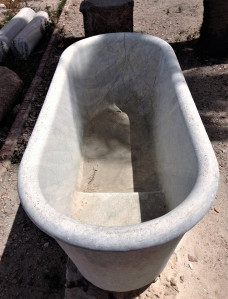guidebook says there’s not much to see at Kom el Dikka (“mound of rubble”), but I respectfully disagree. The archaeological work is ongoing here (and has been since 1960), and you can easily spend an hour or more at Kom el Dikka, looking at the ruins of the city, the beautiful mosaics in the Villa of the Birds, or just enjoying a respite from the noise and traffic of modern Alexandria. (By the way, if you want to look up this location, there are several spellings in English transliteration. The most common alternative is Kom El Dekka.)
The Roman amphitheater here was originally discovered in 1959 when developers began to excavate for a new housing block. Now the excavated area is very large, as archaeological digging has extended far beyond the original find. The group in charge of the dig is Polish, and they’ve provided informative signboards throughout the site, which makes it very easy to imagine what this portion of the city was like from the third through the fifth centuries, CE.
The entire ancient city is well below modern street level, and it’s located in a busy section of Alexandria. When we finally navigated our way to it, we were surprised to realize that Kom el Dikka is right across from the railway station, where u’d just been to buy tickets. You really can’t see anything of the ancient city from the street, other than attractive plantings inside the surrounding fence.
Once you pay your entrance fee and go in, though, it’s like entering a different world. The amphitheater grabs your attention immediately, gleaming white below where you stand. It’s pretty nearly a complete structure, with the original elegant curve of the seating and then a couple of wings added on at different angles to either side. Though it’s a small amphitheater, it’s impressive once you’re standing at ancient-ground level, and looking up at the seating.
You’re not allowed to climb up the seats or stairs, but you can approach the amphitheater from a set of steps above it, and get a feeling for how it would have been to look down from the upper seats and watch a performance under the blue Alexandrian sky.
Beyond the amphitheater and classrooms is a large bath complex (the red-brick structures in the second photo above), where there were apparently steam rooms and exercise rooms as well as the baths themselves. It must have been like a modern gym, where people would go to socialize with their friends while having a sauna, massage or workout. Though the scale is much smaller, it reminded me of being at UCLA in the 1970s – I’d go from a lecture to the gym, have a workout and then a shower and sauna before going to more classes or settling down to study.
I love mosaics, and these are as beautiful as mosaics we saw in Jordan a few years ago, particularly at Madaba, which is famous for its mosaics, and at the museum in Irbid. Mosaics are so delicate, it surprises me how well they seem to survive in some places. I’m guessing there must have been a really great technique for setting the tiny stones so that they could stay firmly in place.
As we made our way across the site, I’d look up every so often at the modern city surrounding us, and realize that this area is just a small piece of the Roman-era city. If you could tunnel under the apartment and commercial buildings all around the edge of this site, you’d find much, much more of centuries-old Alexandria below the cars, buses, billboards and daily life of the modern city.
Apparently Kom el Dikka also had a park, the Park of Pan, where Alexandrians could relax. Today, Kom el Dikka is still a lovely and relaxing place. Above the archaeological site itself, at modern-city street level, are beautiful plantings that turn this historic site into a peaceful retreat from urban traffic and noise. Displayed at this level are also a few large pieces of the Pharaonic city of Alexandria that have been pulled from the sea. They remind you that however old the Roman city is, there was another Alexandria that was even older, going back for centuries.















No comments:
Post a Comment